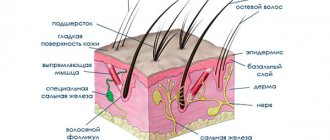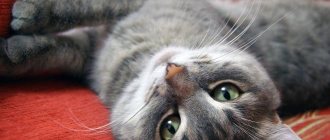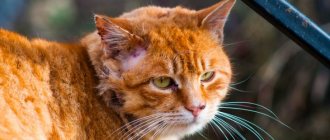The diseases that pets suffer from are quite simple and common, and sometimes they are rare and unusual in their manifestations. These diseases include cutaneous horn. With this pathology, growths appear, each of which looks like a claw growing, for example, on the pad of a cat's paw.
Signs of appearance
In veterinary medicine, this disease is diagnosed quite rarely. And the cat owner may even mistake it for an ordinary claw. Upon closer examination, you can see that this growth:
- dense and hard to the touch;
- with a rough surface;
- conical or cylindrical;
- light or dark color;
- does not exceed 5 cm in length.
Most often, growths appear on the paw pads, but they can also appear on the eyelids, on the nose, and near the animal’s anus. According to the observations of veterinarians, representatives of the Scottish or British breed of cats are especially susceptible to this disease.
Do I need to remove growths on my cat's paw pads?
Growths on the paw pads of cats are not considered uncommon. They look different, some are scary, others are harmless. They can cause discomfort to the pet, which will certainly affect walking.
Appear at any age, regardless of gender. Most often, animals with problems with excess weight, leukemia and immunodeficiency suffer.
In 80% of cases there is no danger; the problem can be solved with medication or surgery.
How does it manifest?
You can notice that a cat has a growth on the pad by the following signs:
- licks his paw;
- limps;
- holds the affected limb in weight;
- meows pitifully when walking.
Even small formations can greatly interfere with movement, which will certainly affect the pet’s activity.
Possible reasons
The rarest causes include allergies, which in isolated cases affect the paw pads. But it is because of it that swelling, similar to a growth, can appear.
This phenomenon can be provoked by insect bites or contact with plants or chemicals. In 90% of cases, everything goes away on its own within 24 hours. Otherwise, the cat must be given an antihistamine and shown to a veterinarian.
Other reasons are much more common, so let’s talk about them in more detail:
- Foreign body. One of the most common causes of a growth on a cat's paw pad. Small splinters can act as splinters (if the house has a wooden floor), needles from plants (cacti, roses), glass fragments, small bones from fish. Getting a foreign body under the skin can provoke an inflammatory or purulent process. This manifests itself in the form of swelling of the limb and the release of pus when pressed. The problem can only be solved by removing the splinter and treating the wound with an antiseptic solution. There are also many cases where a foreign body without an inflammatory process became overgrown with epithelium over time, which ultimately formed the development of a growth on the pad. Such formations can only be removed surgically, provided that it interferes with the animal.
- Ingrown claw. The phenomenon is more common in adults. If your cat is prone to ingrown claws and doesn't have them trimmed regularly, there is a very high chance that it will grow into the soft tissue. After the claw grows into the paw pad, you may notice how the pet begins to limp or hold its paw suspended. After examination, you may notice swelling and redness on the pad and digital ball. If a secondary infection occurs, pus will ooze from the wound. It is advisable to show the animal to a veterinarian so that he can assess the extent of the damage and trim the claw to the required length (it is not so easy to do this correctly yourself). In case of inflammatory processes, it may be necessary to open the wound to clean out pus and claw residues. Subsequently, drainage is applied to the paw, and healing ointments are prescribed.
- Cutaneous horn. Very common among cats aged 2-7 years. It is considered one of the varieties of papilloma that does not pose a threat to the health of the animal. At the initial stage, it looks like a keratinized area of flesh-pink skin. Subsequently it can reach the size of a hazelnut. It is of great importance which side of the pad the growth forms on. If it interferes with walking, it is recommended to remove it. In most cases, the skin horn is not touched, it is observed, since the chance of a malignant course of this type of formation is less than 5%.
- Neoplasms. It mainly affects animals over 10 years of age. Benign tumors can reach enormous sizes, but never metastasize or reappear after removal. It can be distinguished from malignancy using biopsy and cytology. Cancer is also characterized by an aggressive course - rapid growth and manifestation. For fibrosarcomas, the prognosis is guarded. Depending on the size and stage of the tumor, effective treatment is selected - removal of the tumor within healthy tissue or amputation of the limb. X-rays are of great importance in diagnosis to exclude metastases. For lipomas, the prognosis is favorable; the fat capsule itself is removed.
Among the recommendations, I would like to draw attention to the mandatory examination of the animal, starting from the tip of the tail and ending with the nose, for the appearance of growths and tumors. Even a small lump in any part of the body should be a good reason for an emergency visit to the veterinarian.
Loading…
Source: //veterinariya.com/narostyi-na-podushechkah-lap-u-koshki.html
Reasons for appearance
The appearance of such growths is a pathology in which the process of keratin formation and keratinization of cells in the upper layer of the skin occurs too intensely.
The development of the disease can be caused by various provoking factors. The most common of them is the presence of papilloma virus in the animal’s body. It has the ability to transform epithelial cells, causing the growth of warts, growths on the paw pads of cats or other skin formations.
The causes of neoplasms may also be:
- Injury to the claws, their break at the very base or complete separation. In this case, when a new claw is formed, excessive growth of skin tissue is possible.
- Chemical burn or other damage to the skin. The affected area of skin needs a new layer. At the site of damage during the regeneration process, keratinization occurs faster and a so-called horn can form.
- In addition to the papilloma virus, neoplasms and tumors can provoke another fatal disease. The causative agent of viral leukemia suppresses the animal’s immunity and promotes the growth of malignant tumors.
- In most cases, growths in cats are not dangerous and are benign. However, about 5% of neoplasms are malignant. They may be symptoms of squamous cell carcinoma or another cancer.
- In some cases, the pet's growth may turn out to be a cyst.
What causes growths on cats' paws?
Changes in the structure of claws and paw pads, the formation of growths or warts in cats - all this should alert the owner. Growths on the paws of cats are a fairly common pathology and are found in all representatives of the species, regardless of breed. Such neoplasms can cause discomfort to the animal and therefore require treatment.
What is "cutaneous horn"?
New growths on the paws near the claws are called “cutaneous horn”. This name is due to the fact that the growths usually have a dense structure and resemble an extra claw. They are nothing more than tissue proliferation due to keratinization. The causes of the formation of such growths are in most cases viral.
The growths on the paws of Brittanys and other breeds are usually a different color from the paw pads and nails. They can be light, almost white, or dark brown.
Their nature is in many ways similar to ordinary warts. Growths are also caused by papillomavirus, of which there are several dozen.
Leukemia can also provoke proliferation and keratinization (excessive formation of keratin in the epidermis).
The growth itself is in most cases not dangerous and does not cause discomfort to the pet. However, neoplasms require careful monitoring. You should show the animal to a veterinarian and conduct a series of examinations to confirm the benign nature of the growth.
Reasons for the formation of growths
As mentioned above, growths are most often a consequence of the activity of the papillomavirus. Animals are susceptible to this disease to the same extent as people. Infection with the virus occurs against a background of weakening of the body.
Indirect causes of the appearance of tumors on the paws can be considered:
- Decreased immunity.
- Metabolic disorder.
- Elderly age.
- Viral diseases.
- Claw injuries.
Separately, oncological diseases are identified as the cause of the appearance of growths. In cancer, the “skin horn” is a consequence of systemic disorders in the body. Also, growths can appear in response to chemotherapy and other drugs for the treatment of cancer. This is associated with a decline in immunity.
Popular What causes a cat's teeth to become loose?
Severe damage to the claw, for example, as a result of a conflict with a relative or a blow, can lead to the appearance of growths on the cat’s paws. This is explained by the fact that at the site of injury, intensive release of keratin begins and the rate of division of epidermal cells changes, which leads to the formation of the so-called second claw.
Another cause of “cutaneous horn” is keratosis. The disease is characterized by the formation of areas of keratinized epidermis.
Such areas differ in color from healthy skin, the epidermis becomes hard and rough, and peeling is possible. Keratosis is a consequence of the negative effects of household chemicals or sunlight on an area of the skin.
Epidermal disease can develop after injuries, burns or prolonged contact with chemicals.
Why is “skin horn” dangerous?
In most cases, growths on the hind legs of cats are not dangerous and can be successfully treated with both medication and surgery. However, before starting treatment, it is imperative to conduct a histological analysis of the tumor - this will exclude oncology.
Large, dense growths on the paws lead to poor circulation, which may be accompanied by brittle nails or ingrown nails. Often inflammation begins around the growth.
Despite its benign nature, “skin horn” can lead to the development of oncology – squamous cell carcinoma. If the growths are caused by leukemia, there is a high risk of death.
Treatment methods
If you notice a growth on a cat's front paw, you should consult a specialist, but do not try to treat the animal yourself. First of all, it is necessary to exclude oncology and identify the causes of tumors.
If there is only one growth and is small in size, drug treatment at home is practiced. For this purpose, use:
- Aldara ointment;
- Azithromycin tablets;
- Etretinate;
- Acitretin.
Synthetic retinoids should only be used as prescribed by a doctor. The dosage is selected individually in each case and depends on the cat’s weight and general health.
It is important to understand that a course of drug therapy is not a 100% guarantee of complete recovery. The growths go away under the influence of synthetic retinoids, but over time they may appear again.
Popular What can cause a cat to foam at the mouth?
Several large growths on the paws are a reason for surgical treatment. In this case, surgery is preferable, as it eliminates tumors quickly and effectively. Both traditional removal of tumors using a scalpel and more modern methods are practiced - laser removal or cryodestruction of growths.
Source: //KozhaKoshek.com/narostyi-na-lapah-u-koshek.html
Drug therapy
To eliminate cutaneous horn in cats, the necessary treatment is selected only after conducting research, studying tests, and establishing the cause of the pathology.
In some cases, when there is no need for surgical intervention, it is permissible to treat your pet at home. You can treat yourself using medications that are prescribed by a veterinarian. For a certain form of the disease, the most suitable drugs are used.
When the disease is viral in nature, various immunomodulators are used. Such drugs include Aldara cream. When the cream comes into contact with the skin, the substances included in its composition stimulate the body’s immune response and increase the production of interferon.
Rules for using the drug:
- it is applied directly to the affected area, rubbed until completely absorbed;
- treatment is carried out no more than 3 times a week, every other day;
- It is necessary to ensure that the cat does not lick the medicine.
The product "Acitretin" is classified as dermatotropic and has the following properties:
- stimulates tissue regeneration;
- promotes the resorption of scars;
- normalizes the processes of skin keratinization;
The drug must be used strictly under the supervision of a veterinarian, since its mechanism of action remains unknown.
You should know that such remedies only eliminate skin keratinization, affecting only the symptoms of the disease, but not its cause.
To act directly on the causative agents of skin infections, antibiotics should be used. Azithromycin is an antimicrobial drug that is effective against a wide variety of microorganisms. They are usually treated with antibiotics for 10 to 14 days.
Cutaneous horn in cats: basic treatment methods
The most popular methods for combating growths include: medication, surgery, laser, cryotherapy. The decision on the appropriate method is made by the doctor, however, none of the treatment methods gives a 100% guarantee that the skin horn will not appear again after some time.
The surgical method involves excision of the tumor using a scalpel; it is recommended if the growths spread over a large area. After the procedure, stitches are applied, which are removed after about 10 days. Disadvantage: a scar may remain, and there is also a high risk of new growths, since during the operation there is contact with the animal’s blood, and the virus does not disappear from the body.
The most modern treatment options include laser and cryotherapy. These procedures help eliminate the virus and do not leave any traces on the animal’s body. During laser surgery, there is no contact of medical instruments with the skin, which deprives the pet of any unpleasant sensations. But cryotherapy can become very painful for him. The area where the horn grows is treated with liquid nitrogen, after which a dry crust appears at the site of the new growth.
How to treat papilloma with folk remedies
Of course, it is better not to self-medicate your pet, placing this responsibility on the shoulders of professionals. But recipes from traditional healers can be useful in situations where veterinary care is simply not available to people. It is better to discuss the possibility of using folk remedies with a veterinary clinic specialist who has experience in treating papillomas, who will tell you whether you can use the recommendations given. So, supporters of alternative treatment for warts advise:
- lubricate their base with iodine solution;
- apply garlic juice to the papilloma every day for 1-3 weeks;
- Once a day, “burn” the wart with a drop of acetic acid;
- apply a paste of crushed rowan fruits to the papilloma 2 times daily;
- periodically lubricate the tumors with dandelion juice (this method will help cope with recently appeared small warts).
Among other things, according to traditional healers, warts can be removed if you moisten them with freshly squeezed celandine juice 2-3 times daily. The procedure must be continued until the wart disappears completely. Celandine juice can, if necessary, be replaced with milkweed juice.
How dangerous is papilloma for a cat?
When dangerous neoplasms are discovered, breeders are usually afraid of their malignant nature, i.e. They are afraid that their pet will be killed by cancer. In fact, this is not the only outcome of the situation. The problem is that large papillomas are well supplied with blood, especially those located on the mucous membrane, rich in blood vessels. If a cat damages such a wart, it may experience serious bleeding. In severe cases, it will be long-lasting.
As a result of large blood loss, chronic anemia can begin; in young animals, severe bleeding can be fatal. And even minor damage to a cat’s papilloma on the skin, invisible to the eye, can, under unfavorable conditions, lead to contagious inflammation. Warts that form on the paws and between the toes are especially susceptible to these unpleasant processes. No less suffering will befall the animal if the cat has papilloma in the ear, which is “attacked” by ear mites; the mixture of painful phenomena can provoke an inflammatory process that is difficult to treat.
Kinds
There are several types of papillomas in cats.
Oral papilloma
The most common type of warts is found in meowing mustaches 6-9 months old. They appear in the oral cavity, most often on the tongue. Papillomas are oval elevations (numerous) with a flattened top. Warts are usually 4-9 mm wide (diameter).
Multiple viral
Multiple viral papillomas appear in older cats (elderly or middle-aged). Lesions occur over the entire surface of the body (there is no specific localization). The warts are numerous and vary in size (from a few millimeters to 3 cm). There are elongated ones, and in the form of pigmented plaques, and compactions (hyperkeratosis). Some of the papillomas may “degenerate” and the animal will develop squamous cell carcinoma.
Single skin papillomas in cats
This type of papillomas in cats is extremely rarely recorded. Single small warts are observed on the pet's skin. Most often, the disease develops in adult whiskers. Scientists have not been able to prove that this type of wart appears due to a virus.











